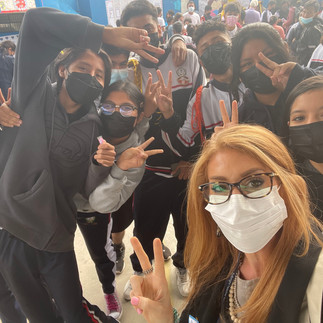Peru - The Reality of Culture & Education
- Kate Strein
- Jun 24, 2022
- 3 min read
Updated: Jun 28, 2022
June 22, 2022
Our International Field Experience (IFE) for the Fulbright Teachers of Global Classrooms (FTGC) program has finally arrived! After a 6 hour flight from Miami, 17 of us from around the US arrived safely in Lima around midnight on Monday. After a very short night’s rest, we began educational sessions bright and early Tuesday morning. The majority of our time Tuesday was spent learning about the Peruvian culture, mostly the disparities and prejudices between the European descent population and the marginalized groups who experience a plethora of discrimination because of their complex intersectionality. The country’s division dates back hundreds of years when Spaniards first betrayed, then conquered, the Incan King. This began a deep-rooted division and mistrust between peoples of European descent and Indigenous populations. An attempt to coexist in a “separate but equal” type of society with dually-existing Republics was unsuccessful, thus creating the tensions and conflicts between groups. In an attempt to simplify the complexities of this multi-ethnic culture, it is quite obvious that the Peruvian people seem to have somewhat of an identity confusion. Most people consider themselves “Mestizaje” or mixed, because of the Spanish, African, and Indigenous influences throughout the country’s history. However, “whiteness” is highly valued, and many people will marry and reproduce with lighter-skinned people in an attempt to improve their social status.
Though racism is considered a crime in Peru, it seems to be a regular practice in subtle ways throughout the government, entertainment, culture, and education. Though this has been the norm for most of the country’s history, in the last decade, activism and anti-discrimination events have began to take place in the metropolis of Lima. Social media has had a large influence on the Peruvian people to empower and educate agents for change.
"If anyone can bring about connection between cultures, it's teachers."
Education
Education is highly valued in this country, and teachers are treated with utmost respect. People understand that in order to move up in society, one must have a formal education. However, access to quality public education has been an ongoing issue. The Ministry of Education provides three tracks for public education: basic, work-force skills, and higher education. Returning to the marginalized populations discussion, there are major educational opportunity gaps between the Euro-centric and marginalized populations. There are many resources and opportunities available for higher education and high performing students, yet there doesn’t seem to be any consistency or reliability with any special education or inclusion programs (or even training for teachers). This brings us to my guiding question for my studies here: What measures and resources does the Ministry of Education (and individual schools) take to accomodate for students with diverse needs (including special education and marginalized populations). Through the school visits and my networking in-country, I will be attempting to find answers to this question. My impression, from the sessions we have had thus far, is that these students seem to be left behind. Though most teachers have the best intentions, without support, resources, and training, they are left frustrated and incapable of differentiating instruction and activities for students with diverse needs. One teacher reported that the inclusion team that has been implemented to provide support in her district only visits classrooms one time per month because they cover seven different schools. Additionally, teachers receive merit-based bonus pay based on student test scores (it’s not just us, America!), so many teachers are hesitant to have inclusion students in their classrooms. Similarly to the US, public schools MUST accept students with disabilities, while private schools are able to be more selective. However, there are no legal requirements to provide accommodations or resources to ensure these students have equal access to a quality education. After collaborating with Embassy representatives and principals, it is apparent that administrators and the Ministry of Education are working towards more inclusive and equitable opportunities for students with special needs. It’s a start. However, one special ed. teacher or support staff may cover 5-7 schools. For non-educators, we have 4-6 per school, who are either in classrooms daily or every-other-day to support students and teachers. Having many schools and students to support, the support person may only visit each classroom once per month. The same applies to school psychologists. It’s a step in the right direction for the country’s education system, but still far from an effective system for students and families.

























Comments